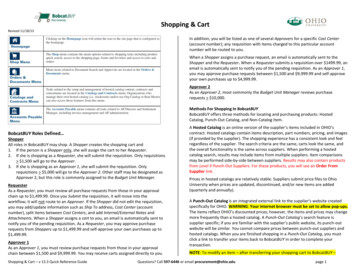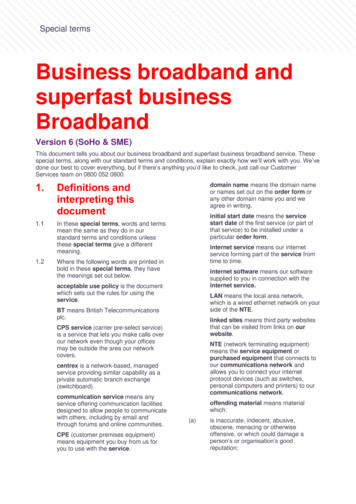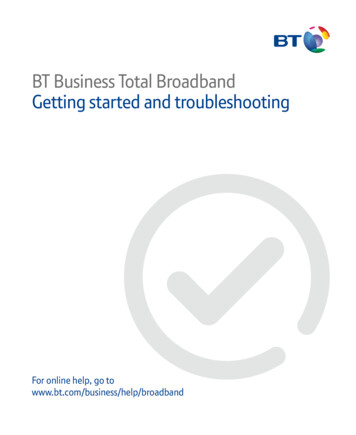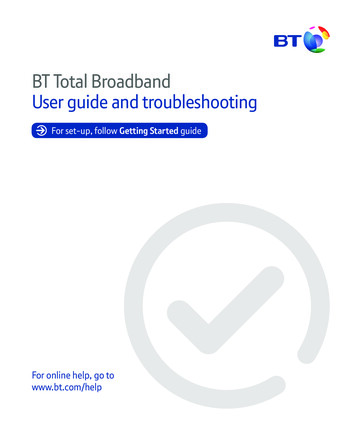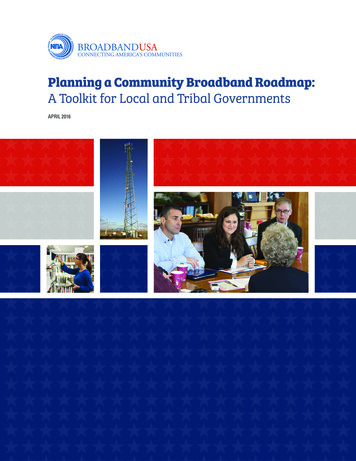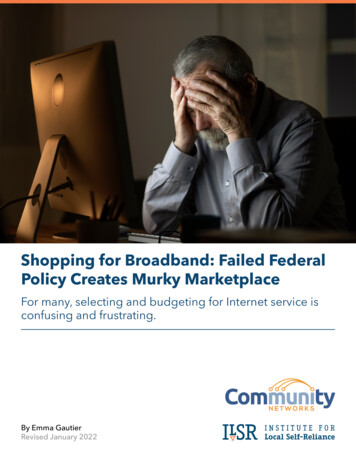
Transcription
Shopping for Broadband: Failed FederalPolicy Creates Murky MarketplaceFor many, selecting and budgeting for Internet service isconfusing and frustrating.By Emma GautierRevised January 2022
About the Institute for Local Self-RelianceThe Institute for Local Self-Reliance (ILSR) is a national nonprofit research andeducational organization founded in 1974. ILSR has a vision of thriving, diverse,equitable communities. To reach this vision, we build local power to fight corporatecontrol. We believe that democracy can only thrive when economic and political poweris widely dispersed. Whether it’s fighting back against the outsize power of monopolieslike Amazon or advocating to keep local renewable energy in the community thatproduced it, ILSR advocates for solutions that harness the power of citizens andcommunities. More at ILSR.org.About the AuthorEmma Gautier researches and analyzes broadband pricing data for ILSR’s CommunityBroadband Networks Initiative. Emma earned her BA in Women’s and Gender Studiesat Carleton College, and has a background in research, data, and political organizing forsocial and environmental justice. She is focused on the synthesis of research and on-theground action in communities.For weekly updates on our work, sign up for the CommunityBroadband Networks ewslettersThis report is licensed under a Creative Commons Share Alike withAttribution license. You are free to replicate and distribute it, aslong as you attribute it to ILSR.Shopping for Broadband: Failed Federal PolicyCreates Murky Marketplace02ILSR.orgMuniNetworks.org
In a large number of communities across the United States, shopping for Internet accessis really challenging. It can be hard for someone to identify exactly what it is they willbe getting when they order any given service, as well as how much they will pay for it.Significant information gaps, as well as inconsistently presented information, make itdifficult for people to navigate the Internet service market.In recent years, groups like Consumer Reports and New America have called attentionto these problems and pushed for the explicit disclosure of service details likedownload speed, upload speed, monthly service cost, and other information thathelps potential subscribers compare providers. The broadband market is opaquein many regards, as detailed by the Federal Trade Commission in an October 2021report outlining a series of concerns with the privacy practice disclosures of sixundisclosed major Internet service providers (ISPs). The fact is that there’s a lot ofinformation large ISPs aren’t telling customers, despite half-hearted attempts by theFederal Communications Commission (FCC) to bring transparency to the market. Ouranalysis finds that while a number of Internet access providers fail altogether to meettransparency requirements, others violate the spirit of transparency—to empowercustomers with information—by burying important service details in difficult-to-reachlocations.In early November, 2021, Congress passed the Infrastructure Investment and Jobs Act(H.R.3684), a 1.2 trillion infrastructure package which includes additional informationdisclosure requirements for ISPs. To underscore the value of these requirements andthe need for their proper enforcement, the Institute for Local Self-Reliance (ILSR) ispublishing a scorecard that highlights just how many ISPs make it difficult for theirpotential customers to make informed decisions when attempting to sign up for Internetservice. The original version of the report assessed the top ten private fixed wireless,private fiber, cable, municipal, and cooperative ISPs based on how clearly they disclosebasic service and pricing information.1 This updated version also includes a second setof fixed wireless providers, which were recommended to us by a wireless ISP advocateafter they suggested the original set was not an accurate representation of that industry.Though many of the fixed wireless providers originally studied do seem to claim thegreatest number of potential customers, we agree with some reviewers that they are notactually among the fixed wireless ISPs with the most subscribers. The scorecard appearsmidway through this report and is preceded by some important context.TABLE 1. COMPARATIVE OVERALL PERFORMANCE BY PROVIDER TYPEProvider TypePerformanceMunicipalExcellentSelected Private Fixed Wireless (Second set)GoodCooperativeGoodPrivate FiberFairCableFairPrivate Fixed Wireless (Original set)PoorThe Internet Transparency Rule, which the FCC originally passed in 2015 as part of theOpen Internet Order, set standards for the information ISPs had to publicly disclose.The rule was designed to offer customers the information they need to make informeddecisions—a necessary condition for any market to function properly. Though thecontents of the Open Internet Order were largely overturned by the Restoring InternetFreedom Order in 2018, the Internet Transparency Rule, for the most part, was leftintact. The rule requires providers to disclose information about network infrastructureand practices as well as speeds and pricing, and mandates that this information bepublished either on a publicly accessible website of the provider’s choosing or on thepublic FCC Internet Transparency Disclosures Portal.Shopping for Broadband: Failed Federal PolicyCreates Murky Marketplace03ILSR.orgMuniNetworks.org
The Transparency Rule, however, is largely unenforced. It is commonly accepted thatwithout effective government regulation or competitive market pressure, ISPs are ina position to abuse their power. The Internet access industry is governed neither byregulation nor market pressure in most communities. Because providers don’t have toanswer to regulation or worry about their customers switching providers if they offerless than satisfactory service, providers are rarely held accountable for informationthat is missing or hard to find. Were providers held accountable for making accessibledisclosures, customers could less easily be exploited. At the expense of Internet accesssubscribers, however, the furthest the FCC has gone to reprimand Transparency Ruleviolators is releasing a series of noncompliance notices.2Even a well-enforced Transparency Rule as it has existed over the past few yearscould not do much more than mandate that the necessary information be publishedsomewhere online. The rule did not standardize the way that providers make theirdisclosures, resulting in a swath of fine print statements designed to satisfy disclosurerequirements rather than empower customers with the information they need, as therule was designed to do.The Infrastructure Investment and Jobs Act reintroduced a consumer broadbandlabel, which standardizes the accessibility and presentation of important Internet serviceinformation including prices, speeds, and fees. The label was first introduced by theFCC in 2015 after New America’s Open Technology Institute proposed the disclosureformat, and was presented as an optional configuration for ISPs to make the disclosuresrequired by the Open Internet Order. More recently, Representative Angie Craig (MN02) pushed the FCC to incentivize providers’ use of the label in the BroadbandConsumer Transparency Act of 2021, but this bill has not been considered to date.3 Theconsumer broadband label mandates that providers use the standardized format todisclose their service information.4Though the inclusion of the broadband consumer label is a huge step forward fortransparency, the label will fail to help customers if left unenforced. The TransparencyRule’s lack of enforcement up to this point has taught us that regulatory or legislativeintent does little to hold ISPs accountable and change the landscape for customers if notaccompanied by real consequences for those who violate the rule.At the very least, the Transparency Rule should protect subscribers from misleadingcustomers through the omission of important information. ISPs, including those whocover the most potential customers nationwide, should not be able to ignore the rulewithout any consequences. One private wireless service provider, for example, offeredat the time of data collection only a series of tier names (Surf Max, Surf Ultra, Surf Plus)along with lists of the online activities appropriate for each tier (email, web-browsing, orvideo, for example).5 The download speeds were discreetly linked only in the site footer,and the upload speeds were missing.Discouraging or punishing ISPs who mislead potential customers should be an elementalcharacteristic of regulation, but there’s actually a lot more the Transparency Rule cando for the Internet service market. It’s true that if the rule were enforced, potentialcustomers would be able to more easily obtain the information needed to comparebetween providers, as well as budget for the monthly cost of broadband service. A lessfrequently considered implication of a well-enforced Transparency Rule is that it wouldallow entrepreneurs and communities to make informed decisions about where tomake business investments and adjustments. Entrepreneurial activity is a critical pieceof cultivating competition and market development, and information gaps are likelyto stifle innovation. Finally, a market with good information is a better environment forconducting analysis, which is key in directing policy.Shopping for Broadband: Failed Federal PolicyCreates Murky Marketplace04ILSR.orgMuniNetworks.org
Private Wireless ProvidersKing Street Wireless000Etheric Networks202Nextlink Internet222Agile Networks100Triad Wireless100THE SCORECARDThe Broadband Transparency Rule Compliance Scorecard tracks the availability andWisper ISP10as of 9/21/2021accessibility of provider disclosures.The providerslisted 0on the scorecardare thosewho111UnWiredBroadband⁷cover the greatest number of potential customers using the following models: privatefixed wireless, privateTWNfiber,cable, cooperative,and municipal.These providersareCommunications222scored between zero and two in download speed, upload speed, and monthly servicecost, according to the following criteria:Data for the ten providers below was collected in November 2021.Selected Private Wireless ProvidersSCORECARD KEY:Nextlink222VTX Communications2220Watch CommunicationsNo informationis available either on the2provider's website or 0the FCC Transparency1Disclosures Portal1AeronetPR2Infomation is availablebut is unclear, incomplete,or difficult to2 find2WisperInformation is availableandISPeasy to find 200222Midcontinent Communications6TRANSPARENCY RULE COMPLIANCE:Broadlinc SCORECARD2222Surf Air Wireless222Mark Twain Communications222as of 11/21/2021Unless otherwise noted, data was collected online from September to October 2021RiverStreet Networks222and will not reflect changes made after thistime. Rule Compliance lessProvidersProviders*After the report’s original publication, a Wireless ISP (WISP) advocate Downloadsuggested ourfixed wireless samplewas non-representativeand askedus to CostSpeedUploadSpeedMonthlyServicereconduct our analysis with the following group of ISPs that have been more aggressive in pursuing federal funding and spectrum opportunities. TheseWISPs greatly outperformed our original sample, which was selected based on those claiming the largest population coverage.Rise Broadband202AT&TAT&TFiber222122King gabit222222Agile NetworksFrontier isperISPGoogleFiber120202UnWired Broadband⁷Metronet121212TWN CommunicationsC Spire Fiber222122Cincinatti Bell221as of 9/21/2021Selected CablePrivateProvidersWireless ProvidersData for the ten providers below was collected in November 2021.NextlinkXFINITY from Comcast222021VTX CommunicationsSpectrum222022WatchCox by Altice222121WisperISPWOW!220202Midcontinent CommunicationsMediacom Cable222221BroadlincSuddenlink Communications222121Surf AirWirelessSparklight (formerlyCableOne)222222RiverStreet NetworksRCN222021Mark Twain WaveCommunicationsBroadband222221Private Fiber Providers*After the report’s original publication, a Wireless ISP (WISP) advocate suggested our fixed wireless sample was non-representative and asked us toreconduct our analysis with the following group of ISPs that have been more aggressive in pursuing federal funding and spectrum opportunities. TheseWISPs greatly outperformed our original sample, which was selected based on those claiming the largest population coverage.AT&T Fiber212Verizon Fios212EarthLink Fiber200CenturyLink Fiber Gigabit222Frontier Communications201Windstream202Google Fiber222Metronet222C Spire Fiber212Cincinatti Bell221XFINITY from Comcast05idersShopping for Broadband: Failed Federal PolicyCreates Murky ox Communications221Optimum by Altice211as of 11/21/2021
Municipal ProvidersCooperativeCable ProvidersPrivate Fiber Providers*After the report’s original publication, a Wireless ISP (WISP) advocate suggested our fixed wireless sample was non-representative and asked us toreconduct our analysis with the following group of ISPs that have been more aggressive in pursuing federal funding and spectrum opportunities. TheseWISPs greatly outperformed our original sample, which was selected based on those claiming the largest population coverage.Shopping for Broadband: Failed Federal PolicyCreates Murky MarketplaceAT&T Fiber212Verizon Fios212EarthLink Fiber200CenturyLink Fiber Gigabit222Frontier Communications201Windstream202Google Fiber222Metronet222C Spire Fiber212Cincinatti Bell221XFINITY from Comcast201Spectrum202Cox Communications221Optimum by Altice211WOW!222Mediacom Cable2211Suddenlink Communications21Sparklight (formerly Cable One)222RCN201Wave Broadband221CarolinaConnect Cooperative Inc.202Peoples Communication, Inc.111Horry Telephone Cooperative, Inc222Guadalupe Valley Telephone Cooperative, Inc.222OzarksGo222Consolidated Cooperative110Nex-Tech, Inc.222West Kentucky Rural Telephone Coop Corp Inc222Douglas Services Inc, dba Douglas Fast Net222South Central Telephone Coop222EPB Fiber Optics222Lafayette City Parish Consolidated Government222Clarksville CDE Lightband222City of Longmont222Jackson Energy Authority222Bristol Tennessee Essential Services222Greenlight222Cedar Falls Utilities222Spanish Fork Community Network222Dalton Utilities22206ILSR.orgMuniNetworks.org
Below are two examples that illustrate disclosures of varying quality. The following setof offerings from municipal provider Clarksville CDE Lightband is an example of goodinformation in all three categories.6The offerings below from private fixed wireless provider Triad Wireless are an exampleof missing information in upload speed and monthly service cost, as well as incompleteinformation on what we assume is download speed (contained in yellow box).7The scorecard offers a series of insights. The most prominent of these is that municipalproviders offer available and accessible information in the three categories analyzed. Onthe other hand, our original set of private fixed wireless providers had the most missinginformation, with only three out of ten offering clear information in all three categories.Cable providers in aggregate had the poorest quality of information, with only twodistinct providers offering clear information.The second set of fixed wireless providers performed much better than the first, withonly two providers offering less than excellent information in all categories. This set ofwireless ISPs had less poor quality information and slightly more missing informationthan our set of cooperatively-run networks.Cooperative providers offer about the same amount of poor quality information asprivate fiber providers, but have less missing information. Additionally, for cooperatives,poor quality or missing information is concentrated to a much smaller number ofproviders. This might say more about those particular ISPs than about cooperativeInternet service providers as a group, but it does mean that the communities coveredby the providers with poor information in all categories really struggle to get theinformation they need to make choices. Though there is a substantial amount of clearinformation among the private fiber providers in aggregate, there are only threedistinct providers that offer available and accessible information in all categories. This,combined with the fact that municipal networks performed the best overall, suggeststhat smaller, local networks are held accountable to a greater degree than their largercounterparts, with more incentives to disclose information more comprehensively andmore accessibly. Our findings in this area add evidence to the claim that governmentpolicy should encourage locally-accountable networks.Shopping for Broadband: Failed Federal PolicyCreates Murky Marketplace07ILSR.orgMuniNetworks.org
Overall, ISPs offer the best information regarding download speeds and the worstinformation regarding upload speeds. Notably, though no cable provider failscompletely to make available its monthly service cost, for a majority of cable providersthis information is unclear or difficult to find. This is the result of a trend that appearsparticular to the cable industry; in many cases, cable providers advertise promotionaloffers, confining the longer term pricing to fine print that is designed to be overlooked.Even prior to the Transparency Rule, an ILSR staffer had an entertaining discussion with anational cable company salesperson going back and forth trying (but failing) to tease outthe non-promotional price for a new account.A MULTIDIMENSIONAL TRANSPARENCY ISSUEThe amount of missing information among 50 of the top Internet providers’ basicservice elements is a striking reminder that the Transparency Rule isn’t being enforced,but missing information isn’t the only problem. There are a number of providers whichtechnically disclose their service information, but do so in a way that is difficult to findor understand. This is to say that even if transparency disclosure requirements as theyhave existed were enforced, accessibility would still be an issue. Customers wouldstill struggle to find the information needed to make decisions, which is exactly thesituation the rule was designed to ameliorate. The scorecard was formulated to capturethe difference between providers that fail altogether to provide information and thosethat provide poor quality information, because enforcement of both the availability andaccessibility of information is essential to solving these important problems.Though not a topic of our own research, privacy policies are another example of an areawhere ISPs are required to make disclosures but often mislead customers by offeringup poor quality information. The aforementioned FTC report examining six major ISPsfound that the “ISP industry’s privacy practices [.] raised concerns in opacity,” amongother areas.8The FTC report shows that some ISPs tell customers that their data will not be sold, butproceed to “use, transfer, or monetize” customer data, disclosing these practices onlyin fine print statements.9 Some ISPs also “purport to offer consumers some choiceswith respect to the use of their data,” but in practice, “problematic interfaces canresult in consumer confusion as to how to exercise these choices, potentially leadingto low opt-out rates.”10 The report also identifies “lack of meaningful access” as aproblem, explaining that “Although many of the ISPs in [the] study purported to offerconsumers access to their information, the information was often either indecipherableor nonsensical without context, potentially leading to low access requests.”11These areas of concern are reminiscent of our concerns when we scored speed andpricing information for the 50 providers. The privacy practices outlined in the FTCreport—along with many of the speed and pricing disclosures scored in this report—are deceptive, and it is affirming to have them formally recognized as such by theFTC. Recognition and concern, however, have yet to translate into any arrangementthat holds ISPs accountable for misleading potential customers. The FCC alleges in asummary document of the Transparency Rule that it is “concerned about providers thatmake false, misleading, or deceptive statements,”12 but in practice, a lack of disclosurestandardization has left room for ISPs to mislead potential customers with complex fineprint statements and a lack of meaningful access to important information.We believe that the simplest policy solutions are often the most effective. Whilebroadband service information can be complex and dynamic, and the consumerbroadband label will not necessarily lead to perfect information within the Internetservice market, it is a very simple policy tool. In the past, the Transparency Rule haslet providers decide how to disclose information, and many have failed to do thatin a way that is accessible. The broadband label, on the other hand, doesn’t leavemuch room for fine print or deceptive practices. Either a provider complies with thelabel format and discloses information in a way that is easy for potential customers toaccess and understand, or it fails to comply and this failure is concrete and visible. Aswas mentioned above, however, the label will only serve customers to the extent itis enforced. Providers will only be held accountable for disclosing information in thisformat if they face real consequences for failing to do so.Shopping for Broadband: Failed Federal PolicyCreates Murky Marketplace08ILSR.orgMuniNetworks.org
POLICY TAKEAWAYS Enforce the newly created consumer broadband label. Increase the number of municipal, cooperatively-owned, and private owned butlocally-owned networks that have incentives more aligned with local residents andbusinesses. Collect the newly standardized pricing information into a publicly accessibledatabase for researchers and policymakers.AREAS FOR CONTINUED RESEARCHAn initial draft of the scorecard contained categories beyond download speed, uploadspeed, and monthly service cost, but this final version was streamlined after weencountered a challenge that we invite others to tackle.In an earlier iteration of this project, we scored providers on the information theydisclosed with regards to data caps and fees.We found, however, that it was difficult to reliably differentiate between a providerthat does not disclose its fees and data caps, and a provider that does not have themat all. In other words, we did not want to penalize a given provider for not disclosinginformation about its data caps or fees if that provider had nothing to disclose in thoseareas. (A marketing tip for ISPs without data caps: you should brag about it.) Nailingdown the difference between nontransparent providers and those offering a service freeof data caps and fees would have meant conducting further research into each providerto identify any service offerings information not listed online.While it is challenging information to collect, a dataset detailing the extent to whichdifferent types of providers disclose data caps and fees would offer a more holisticrendering of Transparency Rule compliance across the Internet service market.Supplementing our dataset with information about fees is particularly important becausethe category “monthly service cost” will frequently fail to represent the true sum ofwhat a customer pays. A recent survey published by New America’s Open TechnologyInstitute identifies fees as an important component of the total price of Internet access,citing fees for installation, equipment, early termination, or data overages (one reasonit’s helpful to know if a provider caps data usage) which increase prices by no meageramount.13 When these fees are combined with complex pricing structures—like thepromotional pricing model that seems elemental to national cable ISPs—the result is aset of offerings that is even more challenging to navigate and plan for. Understandingthe extent to which the cost of Internet access is inflated by fees and post-promotionalcharges, along with whether providers disclose them, will allow us to better illustrate theInternet transparency landscape.We also encourage further research to determine whether there is as much variationamong other types of providers as we saw among fixed wireless providers. While we didexpect to see variability between wireless ISPs in particular, we are curious to understandwhether this variability in transparency exists in other industries. This could help usunderstand exactly why it is that some providers fail to offer available and accessibleinformation to potential customers.We invite further research to investigate these additional dimensions and pursue yetother categories of information as to further qualify the Internet transparency problemand the way it varies by type of provider. That said, the consumer broadband labelrequires providers to disclose the fees associated with their services, as well as bothpre- and post- promotional prices. The label should make it easy to identify and penalizeproviders that fail to meet Transparency Rule requirements and in doing so wouldintroduce a more overt form of accountability than what currently exists.Shopping for Broadband: Failed Federal PolicyCreates Murky Marketplace09ILSR.orgMuniNetworks.org
IN CLOSINGThe Transparency Rule Scorecard is an affirmation of what many customers,entrepreneurs, researchers, and policymakers already know to be true—that it’s hard tofind information about Internet service. The scorecard is a reflection of the broadbandcustomer experience nationwide and the frustrations wrapped up in that. It is also anacknowledgement of the transparency problem’s various dimensions, and a gesture to asimple policy solution recently passed by Congress that, if enforced, has the potential tomake selecting Internet service much easier.Shopping for Broadband: Failed Federal PolicyCreates Murky Marketplace10ILSR.orgMuniNetworks.org
ENDNOTES1 The largest private fiber, cable, and original private fixed wireless provider listswere generated by Broadband Now and are based on estimated population covered.Broadband Now offered no lists for municipal nor cooperative networks. Our list oflargest cooperative networks was drawn from Form 477 and ILSR data. Our list of largestmunicipal networks is based on our knowledge of the space. Providers that offered noresidential service were removed. Everywhere Wireless was removed from the list ofprivate fixed wireless providers because of its unique Wi-Fi infrastructure installed only inapartment buildings. Altice was removed from the private fiber list because it uses only afiber backbone to deliver service rather than complete fiber-to-the-home infrastructure.Open access networks were removed from the list of municipal providers due to varyingmarketing approaches by the various ISPs. For top ten lists where providers wereremoved, the next largest provider was considered. The decision to use the largest ISPswas made to avoid any appearance of favoritism in which ISPs were included.2 JSI Telecommunications Consulting (2018). FCC Begins Enforcement of UpdatedNetwork Transparency Rules. ednetwork-transparency-rules/.3 Schwantes, Jonathan (2021). The Rise, Fall, & Return of the Consumer BroadbandLabel. Consumer Reports. bel/.4Infrastructure Investment and Jobs Act (H.R.3684), 117th Congress (2021-2022).5Wisper ISP.6 Residential Internet offerings for Clarksville CDE Lightband. https://cdelightband.com/residential/internet/. Accessed 10/5/2021.7 Residential Internet offerings for Triad Wireless. /. Accessed 10/5/2021. Triad responded to the original report bynoting that it is a small company that has made remarkable investments and seen rapidgrowth in recent years that left it unable to prioritize a website that clearly identifieswhat speed tiers are available, in part due to the many different technologies used.8 Federal Trade Commission (2021). A Look At What ISPs Know About You: Examiningthe Privacy Practices of Six Major Internet Service Providers. 02 isp 6b staffreport.pdf .9Ibid.10Ibid.11Ibid.12 Federal Communications Commission. Consumer Guide: Open InternetTransparency Rule. https://www.fcc.gov/file/15379/download#: :text ices%20about%20speed%20and%20price . Accessed 11/7/2021.13 Chao, Becky; Park, Claire (2020). The Cost of Connectivity. New America’s OpenTechnology Institute. eCost of Connectivity 2020 XatkXnf.pdf .Shopping for Broadband: Failed Federal PolicyCreates Murky Marketplace11ILSR.orgMuniNetworks.org
The Internet Transparency Rule, which the FCC originally passed in 2015 as part of the . make business investments and adjustments. Entrepreneurial activity is a critical piece . Cox Communications 2 2 1 Optimum by Altice 2 1 1 WOW! 2 2 2 Mediacom Cable 2 2 1 Suddenlink Communications 2 1 1

